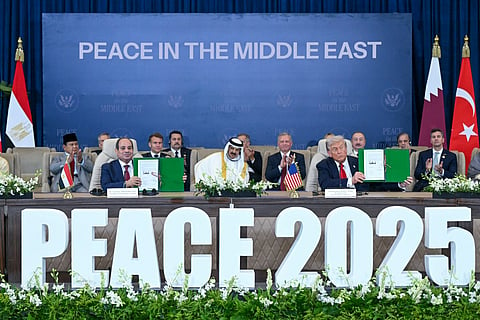Will Hamas disarm? Who rules Gaza? Big questions remain after Gaza peace deal is signed
Four leaders sign Cairo declaration pledging peace, dignity and regional cooperation

Dubai: The signing of the Gaza ceasefire agreement brokered by US President Donald Trump marks a dramatic moment in the two-year conflict — but, the hardest part may still lie ahead. Beneath the celebrations in Gaza, Cairo and Jerusalem, the road toward disarmament, governance and reconstruction is fraught with uncertainty and risk.
Will Hamas disarm?
One of the most contentious unresolved issues is Israel’s insistence that a weakened Hamas must completely disarm. According to reports, Hamas refuses, demanding instead that Israel withdraw all its troops from Gaza.
Israeli Prime Minister Benjamin Netanyahu has vowed that Gaza will be “demilitarised,” promising that if Hamas will not disarm “the easy way,” Israel will ensure it happens “the hard way.”
For now, Israel has pulled back from Gaza City and Khan Younis but still controls roughly half the enclave, including parts of Rafah, northern towns, and a wide security belt along the Israeli border.
The uncertainty over how and when Hamas will disarm — and who will supervise it — is at the heart of skepticism about whether the ceasefire can evolve into durable peace. Without a verified mechanism for disarmament, experts warn, renewed fighting remains a constant threat.
Who will govern Gaza?
Equally fraught is the question of Gaza’s postwar governance. Under Washington’s plan, Gaza is to be administered temporarily by an international body that will oversee Palestinian technocrats managing daily affairs. Hamas and other militant factions will have no role.
Trump declaration: What four leaders signed in Cairo
While uncertainty lingers over the next steps in the Gaza peace process, four world leaders on Monday signed a declaration in Egypt titled “The Trump Declaration for Enduring Peace and Prosperity.”
It was signed by US President Donald Trump, Egyptian President Abdul Fattah al-Sisi, Qatari Emir Sheikh Tamim bin Hamad Al Thani, and Turkish President Recep Tayyip Erdogan.
According to the declaration released by the White House:
Historic commitment: The leaders hailed the implementation of the Trump Peace Agreement as a turning point ending more than two years of conflict and suffering in Gaza.
Support for Trump’s peace plan: They pledged to back efforts to secure “lasting peace, security, stability and opportunity” for both Palestinians and Israelis.
Mutual rights and dignity: The declaration stresses protection of fundamental human rights and dignity for all peoples of the region.
Dialogue over force: Future disputes, it says, must be resolved through diplomacy and negotiation rather than violence or prolonged conflict.
Respect for faith heritage: It acknowledges the deep spiritual significance of the region to Christianity, Islam and Judaism, pledging to protect all holy sites.
Combating extremism: The leaders vowed to dismantle radical ideologies, address conditions that breed extremism, and promote education, opportunity and mutual respect.
Regional cooperation: They agreed to strengthen bonds among nations to build stability and shared prosperity.
Equal opportunity: The statement calls for tolerance and economic opportunity for all, regardless of race, faith or ethnicity.
Shared vision: It envisions a Middle East where Palestinians and Israelis can prosper together in peace, grounded in mutual respect and a sense of shared destiny.
The framework also leaves room for a future role for the Palestinian National Authority, but only after sweeping internal reforms — a condition that has long delayed its involvement. Israeli leaders have historically opposed any expansion of the Authority’s powers, while Hamas insists that any new government must emerge from Palestinian consensus.
The peace plan vaguely acknowledges an “aspiration” for an independent Palestinian state, but without a timetable or roadmap. Netanyahu continues to reject the creation of such a state, calling it a threat to Israel’s security. The ambiguity reflects a familiar pattern in decades of peace efforts — optimism at the outset, uncertainty in the details.
Who will secure Gaza?
Security is another open question. The deal envisions an Arab-led international force, supported by Palestinian police trained in Egypt and Jordan, taking control as Israeli troops withdraw. Yet AP points out that the plan does not specify which countries will contribute troops, how the force will respond to resistance on the ground, or who will coordinate between Israeli and Arab units.
This hybrid model — part Arab coalition, part local police — may prove difficult to manage. Past international missions in the region have faltered amid unclear mandates and political rivalries. For Gaza, success will depend on coordination between Egypt, Israel, and the United States — a delicate balance after years of mistrust.
A long road to rebuild
Even if security and governance issues are sorted, the physical and psychological toll of two years of war is immense. Tens of thousands of Palestinians have been killed, and more than 90 percent of Gaza’s population displaced. AP cites the World Bank, the UN, and the European Union as estimating that reconstruction could cost $53 billion.
Arab nations are expected to contribute, but many will demand assurances of political progress and a credible path to Palestinian self-rule. As Lucy Kurtzer-Ellenbogen of the Middle East Institute told AP, “There’s really no luxury of sequencing here — everything has to happen all at once.”
A fragile peace
From Madrid to Oslo and beyond, previous US-led initiatives have collapsed under the weight of mistrust. Analysts quoted by AP warn that this ceasefire — though momentous — could prove to be a “fragile pause” rather than a foundation for peace.
As Trump hailed the accord as “the end of the war in Gaza,” even allies acknowledged the complexity of what comes next. “It’s a good day,” said former US diplomat Robert Wood, “but the war isn’t over yet.”
For now, Gaza stands at a crossroads — between the promise of renewal and the peril of relapse.
Sign up for the Daily Briefing
Get the latest news and updates straight to your inbox




